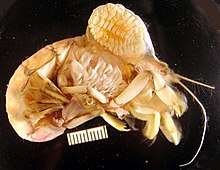Orthione griffenis
Orthione griffenis is a isopoda parasite present in the waters off East Asia and the West Coast of North America.[1]
| Orthione griffenis | |
|---|---|
 | |
| Upogebia pugettensis with a female Orthione greffenis on its gill flap | |
| Scientific classification | |
| Kingdom: | |
| Phylum: | |
| Subphylum: | |
| Class: | |
| Order: | |
| Family: | |
| Genus: | |
| Species: | O. griffenis |
| Binomial name | |
| Orthione griffenis (Markham, 2004) | |
Description
Orthione griffenis is a Epicaridean isopoda parasite that is found on the gill chamber of Upogebia mud shrimp.[2] Female O. griffenis are quite different from their male counterpart. Females have an oblong body, that is typically 6-24mm long with a width of half the length. Males are the smaller sex with a body that resembles more of a cylinder than an oval, 8mm long and 3mm wide. Females have 6 pleons and males have 7.[1][3] O. griffenis are hatched as larva that attach themselves to copepod, and then metamorphose into a microniscus larva. After that they molt several times until they become cryptonicus larva that then infect mud shrimp.[3]
Distribution
Orthione griffenis is a native species to the coasts of Russia, Japan, South Korea, and China. O. griffenis was first recorded on the coast of Willapa Bay, Washington, in 1988. Since then, O. griffenis has established itself from British Columbia, Canada to Baja California, Mexico.[3] They were likely introduced from cargo ships bound from Asia emptying their ballast tanks off the coast of North America.[4]
Ecology
After being introduced from Asia, Orthione griffenis have established themselves by infecting Upogebia pugettensis (mud shrimp). O. griffenis typically infects female U. pugettensis rather than male (80% compared to 57%).[5] They attach themselves to the gill chamber, where they suck the host's blood. This causes a metabolic burdening effect that greatly hampers reproductive ability, which has led to a significant decline in U. pugettensis. Hatfield Marine Science Center has found that all documented populations of U. pugettensis are infected with O. griffenis, and mud shrimp populations in 4 of 18 estuaries have gone extinct as of 2008.[4]
References
- Dave Cowles. "Orthione griffenis". inverts.wallawalla.edu. Retrieved 2020-02-09.
- "WoRMS - World Register of Marine Species - Orthione griffenis Markham, 2004". www.marinespecies.org. Retrieved 2020-02-09.
- "NEMESIS Database Species Summary". invasions.si.edu. Retrieved 2020-02-09.
- "Research". Hatfield Marine Science Center. 2012-02-29. Retrieved 2020-02-09.
- "Upogebia pugettensis". inverts.wallawalla.edu. Retrieved 2020-02-09.